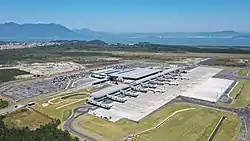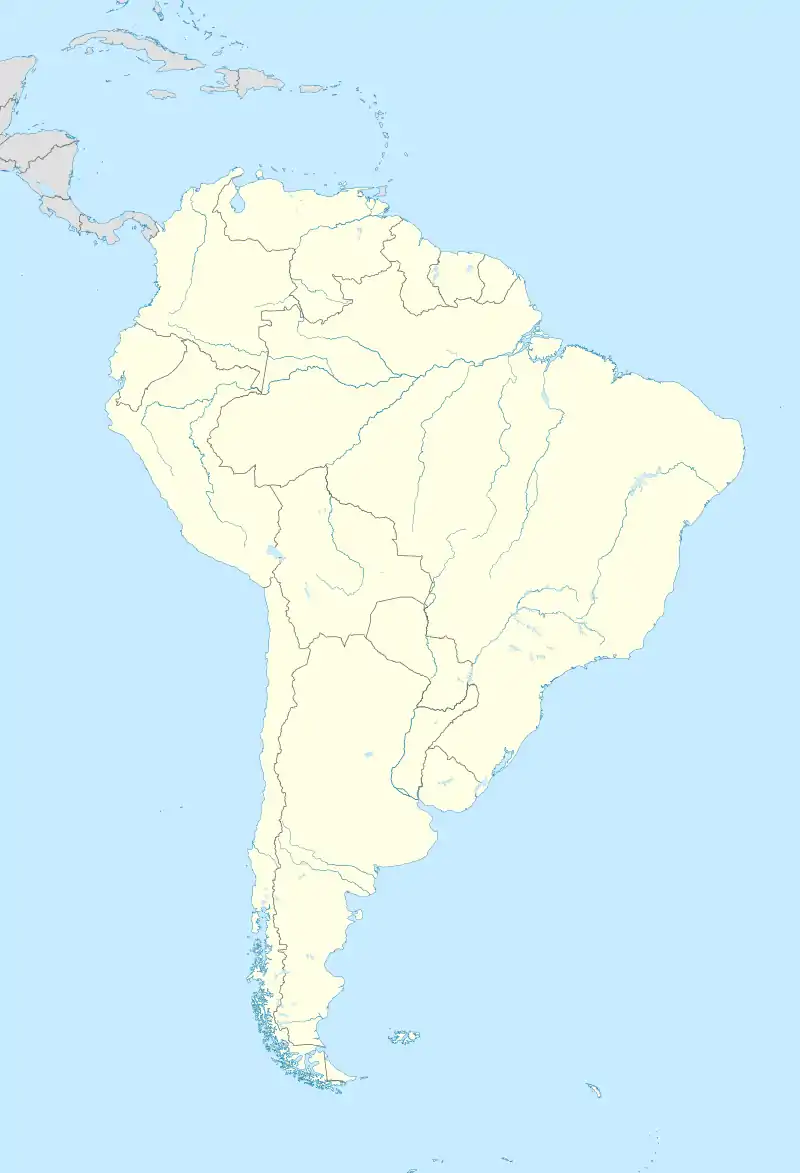Hercílio Luz International Airport
Florianópolis-Hercílio Luz International Airport (IATA: FLN, ICAO: SBFL), branded Floripa Airport, is the airport serving Florianópolis, Brazil. It is named after Hercílio Pedro da Luz (1860–1924), three times governor of the state of Santa Catarina and senator. It is operated by Flughafen Zürich AG. Some of its facilities are shared with the Florianópolis Air Force Base of the Brazilian Air Force.
Florianópolis-Hercílio Luz International Airport Aeroporto Internacional de Florianópolis-Hercílio Luz | |||||||||||||||
|---|---|---|---|---|---|---|---|---|---|---|---|---|---|---|---|
 | |||||||||||||||
 | |||||||||||||||
| Summary | |||||||||||||||
| Airport type | Public/Military | ||||||||||||||
| Owner/Operator | Floripa Airport | ||||||||||||||
| Serves | Florianópolis | ||||||||||||||
| Opened | 1927 | ||||||||||||||
| Focus city for | |||||||||||||||
| Time zone | Time in Brazil (UTC−03:00) | ||||||||||||||
| Elevation AMSL | 5 m / 16 ft | ||||||||||||||
| Coordinates | 27°40′13″S 048°33′09″W | ||||||||||||||
| Website | floripa-airport | ||||||||||||||
| Map | |||||||||||||||
 FLN Location in Brazil  FLN FLN (South America) | |||||||||||||||
| Runways | |||||||||||||||
| |||||||||||||||
| Statistics (2019) | |||||||||||||||
| |||||||||||||||
History
The airport was built on the site of an old Air Naval Base, which operated until 1941, when its jurisdiction changed to the Brazilian Air Force.
Between 1927 and 1932, the then known as Campeche Field was also used by the French aviators of the Compagnie Générale Aéropostale for its operations in Florianópolis. Among them were Jean Mermoz, Antoine de Saint-Exupéry and Henri Guillaumet.
Between 1942 and 1945 the runway 03/21, apron, control tower and passenger terminal were built. At the same time, some facilities of the Florianópolis Air Force Base were built and made operational.
In the period between 1952 and 1954 the passenger terminal was rebuilt and was operational until 1976 when a brand-new terminal building and apron were opened. The old facility is today the cargo terminal. The new terminal was further enlarged in 1988 and 2000, reaching the present 8,703 m².
In 1978 the runway 14/32 was opened allowing a great increase in traffic. In 1995 the airport was upgraded to international category and started receiving particularly seasonal and charter flights from Argentina, Chile, Paraguay and Uruguay.
On March 16, 2017, Flughafen Zürich AG was awarded the concession to operate and expand the airport, owning 100% of it.[4]


On January 15, 2018, the new concessionaire began construction of a new terminal with 14 new gates - 3 international and 11 domestic. The cost of the project was BRL 570 million.[5] The new terminal, located on the opposite side of the main runway from the old one, was officially opened on September 28, 2019.[6] The main runway was also extended by 100 metres (330 ft), to 2,400 metres (7,900 ft).[7][5][6] Operations using the new terminal started on October 1, 2019.[8]
Airlines and destinations
Cargo
| Airlines | Destinations |
|---|---|
| Total Linhas Aéreas | Curitiba, São Paulo-Guarulhos |
Accidents and incidents
- 22 March 1951: a Cruzeiro do Sul Douglas C-53D-DO plane, registration PP-CCX while landing at Florianópolis crashed following an overshoot in bad weather and an engine failure. Of the 14 passengers and crew, 3 died.[12]
- 12 April 1980: a Transbrasil airplane, flight 303 Boeing 727-27C registration PT-TYS flying from São Paulo-Congonhas to Florianópolis was on a night instrumental approach to Florianópolis under a severe thunderstorm. The aircraft went off course, struck a hill and exploded. Probable causes are misjudgment of speed and distance, inadequate flight supervision, failure to initiate a go-around and improper operation of the engines. Of the 58 passengers and crew aboard, 3 passengers survived.[13][14]
Access
The airport is located 14 km (9 mi) from downtown Florianópolis.
References
- "Movimento de passageiros e voos". Floripa Airport (in Portuguese). Retrieved 3 May 2020.
- "Floripa Airport". Floripa Airport (in Portuguese). Retrieved 13 September 2019.
- "Aeródromos". ANAC (in Portuguese). 15 October 2019. Retrieved 3 May 2020.
- "Flughafen Zürich AG wins concession for airport in Brazil". Flughafen Zürich. 16 March 2017. Retrieved 17 March 2017.
- Martins, Marcos (28 September 2019). "CEO do Floripa Airport explica investimento no novo terminal" [Floripa Airport CEO explains investment in the new terminal]. Panrotas (in Portuguese). São Paulo. Retrieved 2 October 2019.
- Martins, Marcos (28 September 2019). "Autoridades inauguram novo aeroporto de Florianópolis" [Authorities open new Florianópolis Airport]. Panrotas (in Portuguese). São Paulo. Retrieved 2 October 2019.
- "SEU CONFORTO LÁ NAS ALTURAS". Floripa Airport. 10 March 2019. Retrieved 10 March 2019.
- "Veja fotos do novo aeroporto de Florianópolis". Panrotas (in Portuguese). 29 September 2019. Retrieved 2 October 2019.
- "Aerolíneas Argentinas reabre voos para 6 cidades brasileiras de uma vez". Aeroin (in Portuguese). 8 September 2020. Retrieved 9 September 2020.
- "Paranair anuncia vuelos de temporada a Floripa y Río". Aeronauticapy (in Spanish). 3 December 2020. Retrieved 9 December 2020.
- "Florianópolis recebe 1º voo internacional desde março". Panrotas (in Portuguese). 4 December 2020. Retrieved 7 December 2020.
- "Accident description PP-CCX". Aviation Safety Network. Retrieved 21 July 2011.
- "Accident description PT-TYS". Aviation Safety Network. Retrieved 21 July 2011.
- Germano da Silva, Carlos Ari César (2008). "Transbrasil 303". O rastro da bruxa: história da aviação comercial brasileira no século XX através dos seus acidentes 1928–1996 (in Portuguese) (2 ed.). Porto Alegre: EDIPUCRS. pp. 313–317. ISBN 978-85-7430-760-2.
External links
- Airport information for SBFL at World Aero Data. Data current as of October 2006.Source: DAFIF.
- Airport information for SBFL at Great Circle Mapper. Source: DAFIF (effective October 2006).
- Current weather for SBFL at NOAA/NWS
- Accident history for FLN at Aviation Safety Network